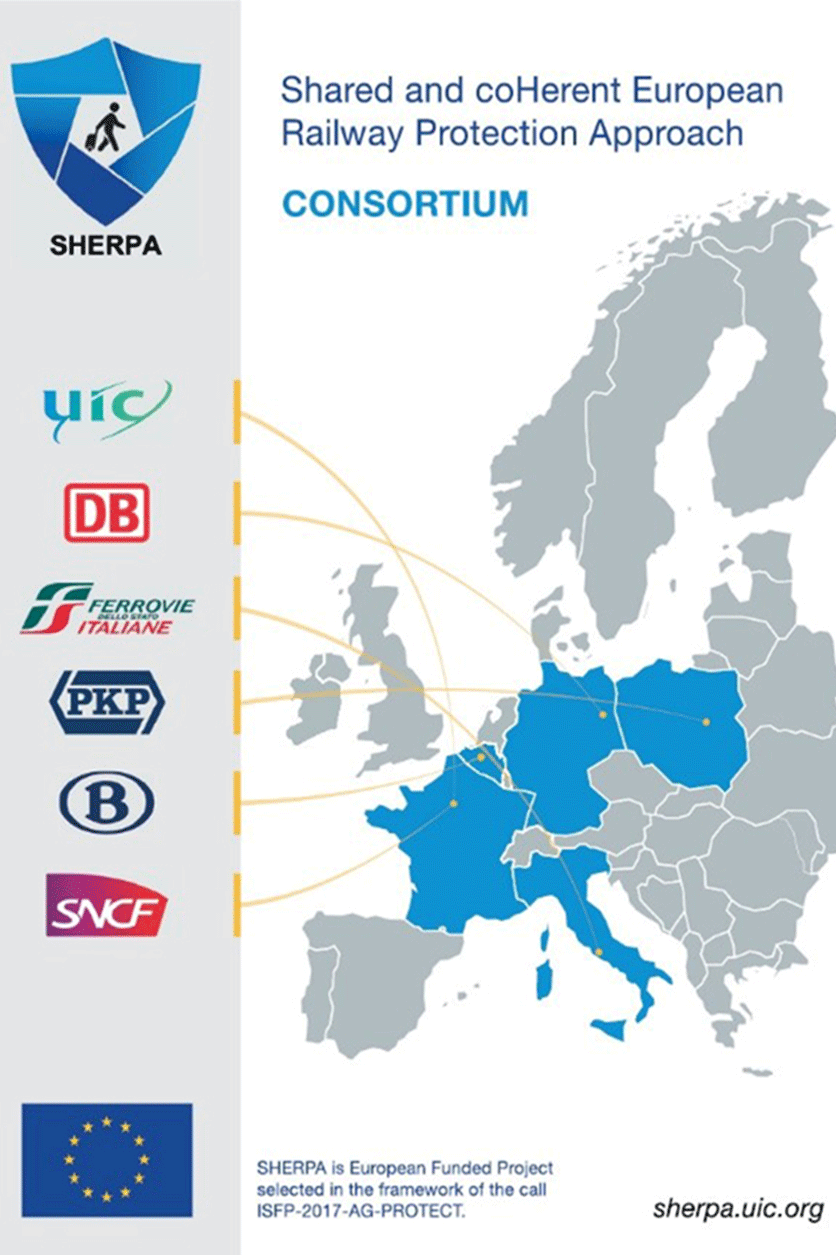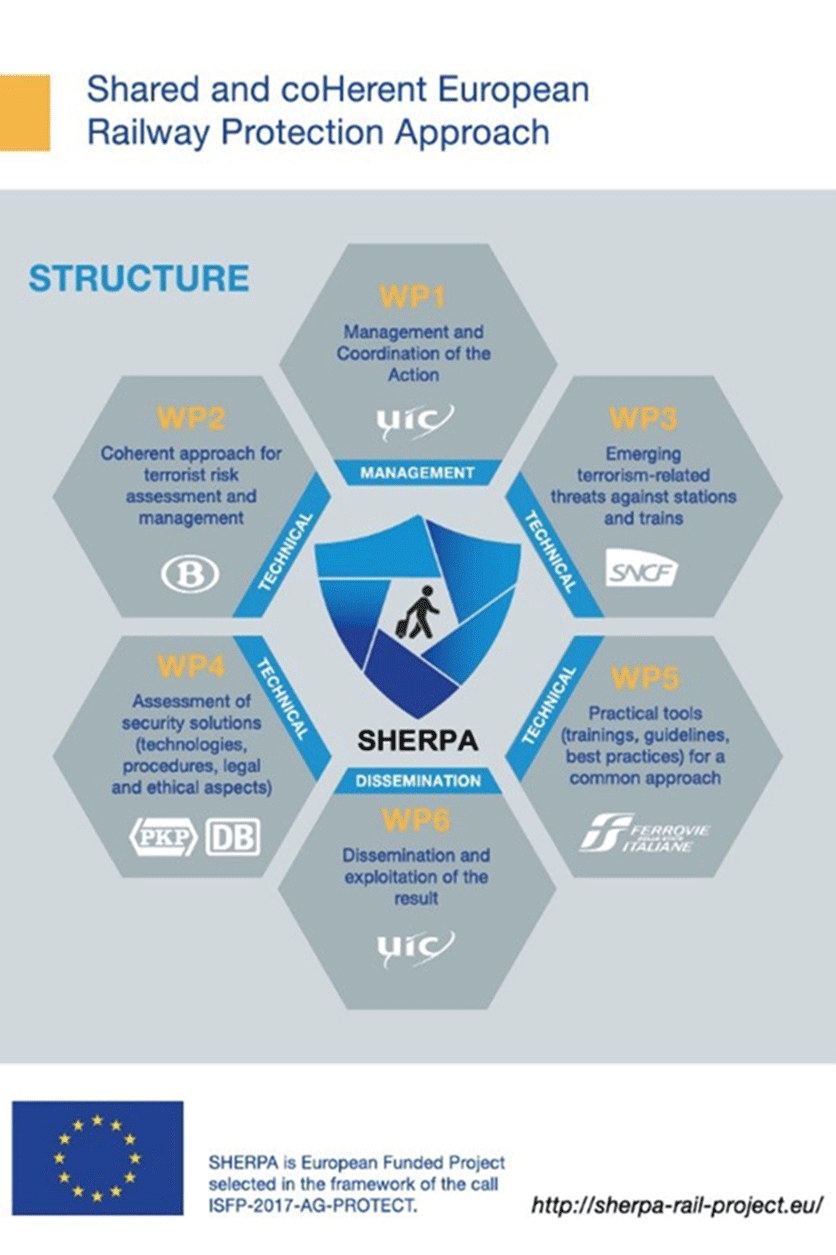Protecting stations and trains against terrorist attacks
Posted: 20 September 2019 | Marie-Hélène Bonneau | No comments yet
The ‘open’ nature of trains and stations continually make them targets for terrorist attacks. But with EU-funded project SHERPA, coordinated by the UIC, key players in the railway sector are coming together to focus on the various actions that will help railways cope better with present and future threats. Marie-Hélène Bonneau, Head of the UIC Security Division and is Coordinator of the SHERPA project explains more.


Terrorist attacks carried out in the latest years show an alarming increase of indiscriminate violent actions carried out against civilians gathering in public spaces. Railway transport represents a critical infrastructure for any European country and stations and trains can be regarded as ‘soft’ targets due to their nature of inherently open systems. Several initiatives aiming at increasing the protection from terrorist attacks were undertaken in the past years at various levels, nevertheless the knowledge about the phenomenon itself and possible counter-measures is still quite fragmented and presents many gaps.
Therefore, SHERPA which stands for Shared and coHerent European Railway Protection Approach is an EU project aimed at addressing railway security issues in the most complete and comprehensive manner by stock-taking and putting together of the most up-to-date knowledge and best practices drawn from the latest attacks and lessons learnt. It is addressing each of the key security areas that make up an integrated and complete approach to railway security. The project is addressed to a wide group of railway personnel both at management (to help to define and put in place coherent and effective security strategies and policies) and operational level (to better train and support those on the ground (practitioners) who are in charge of protecting and making railway users to feel secure and safe on a daily basis).




SHERPA project description
SHERPA is a European Union funded project selected in the framework of the call for proposals for projects on protection of public spaces. It started on 1 November 2018 and will run for two years.
The Sherpa Consortium is coordinated by the UIC (International Union of Railways) and composed of five European rail companies: DB AG (Germany), FS (Italy), PKP SA (Poland), SNCB (Belgium) and SNCF (France). These key players in the railway sector are coming together to focus on various actions that will help railways to better cope with present and future terrorist threats.
The main objective of the project is to improve the overall security level of railway stations and trains against terrorism in all its possible forms, including both known and emerging ones such as insider threats, and misuse of Unmanned Aerial Vehicles across Europe.
Description of the work:
The work is divided into the following four technical work packages (WP):
WP2: Coherent approach for terrorist risk assessment and management
WP2 is now complete with a report on ‘Risk Assessment and Management’ available since March 2019.
The first part of the document focuses on the analysis of the terrorist acts committed in recent years as well as the lessons learned from past events. This part is particularly useful because the collective focus of the public authorities and companies in terms of security is primarily on preventing acts that have already taken place from re-occurring, rather than defending against emerging threats.
Regarding the risk assessment for terrorism, the public authorities and, in particular, the intelligence services are responsible for identifying threats and the occurrence thereof. In parallel, it is – of course – up to transport companies themselves to define the vulnerabilities to which they are exposed, as well as particularly sensitive areas or situations.
There is a need to prevent the re-occurrence of terrorist attacks and, at the same time, assess possible acts not in terms of likelihood – the terrorist threat is liable to adapt and continuously react to security countermeasures – but, rather, in terms of the consequences with regard to victims and damage to facilities and property.
Rather than thinking about the security investment required in terms of probability and efficiency, this will at least enable stakeholders to frame the analysis in terms of unacceptable situations that require implementation of solutions to ensure that they never occur. Furthermore, depending on the economic or political context, other investments or actions may be put in place when possible security events are categorised in accordance with the seriousness of their consequences, whether in terms of the number of potential victims, the need for rapid resumption of service or other specific considerations at national level.
Questions also need to be asked about the impact of security measures, particularly anti-terrorist measures, put in place in ‘normal’ conditions and in the absence of specific events, which may have an effect on customers’ and employees’ perception and on whether they feel safe or unsafe. If we want railway stations to remain open urban living spaces, steps must be taken to ensure that a certain level of passenger comfort and well-being is maintained.
On another note, though the terrorist threat is certainly very much present, customers are also sensitive to delinquency or conventional ‘day-to-day’ violence – perhaps even more so – which may influence decisions on whether or not to take the train.
Finally, the international or European element must be taken into account insofar as passengers should enjoy comparable levels of protection when they travel, for example when they travel to and from one country to another. Otherwise, they will fail to understand the measures in place and, on the contrary, may develop a feeling of inconsistency with regard to the railway companies taking them from A to B.
WP3: Analysis of emerging terrorism-related threats against stations and trains
The ongoing objectives of WP3 are to identify and assess emerging threats potentially targeting stations and trains throughout Europe, to stocktake and share an updated knowledge base on the matter and to set requirements and priorities for industry, research and policy making bodies.
Protecting passengers and railway staff is always paramount, and the whole network needs to be assessed to reduce risks in stations and on-board trains. Faced with these key security and business related issues, cooperation with sovereign authorities is the only way forward for railway companies, to identify and prepare for emerging threats, and detect early on the appearance of new modus operandi, always keeping in mind the financial restrictions they underly.
WP4: Assessment of security solutions (technologies, procedures, legal and ethical aspects)
The work just started with the objective to build a common and updated knowledge base, validated by users and external experts, featuring the most efficient solutions (both technologies and procedures) for protecting trains and stations. This WP will also identify the gaps to be fulfilled and needs for the future for better securing stations and trains in accordance with the business constraints.
The security solutions identified and assessed in the project will be updated in the UIC security hub which is accessible by authorised stakeholders in Europe (Rail companies and authorities). This online platform provides end-users with a database of security solutions (presented in form of fact sheet) easily searchable with a series of keywords, along with other functions and items related to railway security and cooperation with stakeholders like police, transport authorities, first responders, etc.
WP5: Practical tools (training, guidelines, best practices)
The objective of this WP is to design and deliver practical tools (international training, best practices and guidelines) aimed at fostering a common effective approach to the protection of stations and trains from both already experienced and emerging security threats. There are three main practical tools planned to be delivered:
- Three-day international training on security for operational security staff The training will be aimed at improving awareness, responsiveness and cooperation between all the relevant stakeholders (railway security staff, police, first responders) to effectively manage security threats with a focus on terrorism and other emerging threats potentially affecting the railway system, both on a regular service and during big events (such as Olympic games, football championships, G8 summits)
- Common guidelines for railway management to handle and mitigate the risks coming from insider threats The guidelines will be designed to support railway managers in effectively addressing all the issues related to potential insider threats (hereby identifying those coming from both railway employees and external suppliers of goods and services) within the operational context of railway stations and trains
- Best practices on digital media Such as mobile apps or social networks for raising security awareness and improving crisis communication with the public.
Expected impact of the project
The positive impacts on the protection of stations and trains resulting from the SHERPA project shall be those of:
- Enhancing the cooperation on terrorism related threats and issues at European level among rail companies and between them and the relevant authorities
- Promoting a coherent approach to rail security across Europe and reaching a fair balance between security needs and ethical and legal aspects
- Raising awareness on the terrorist threat in all its already known and potentially emerging forms by collecting, validating, enhancing and sharing most up-to-date knowledge and know-how in all the relevant domains
- Helping decision-makers to identify and implement the most appropriate and effective security solutions (in the human factor, technical and policy/organisation domains) for protecting persons, stations and trains against terrorism-related threats (both known and emerging).
Biography










